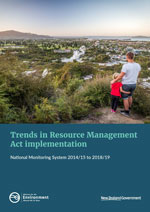This report highlights patterns and trends in implementation of the Resource Management Act by local authorities from 2014/15 to 2018/19, as recorded by the National Monitoring System. The purpose of the report is to identify areas for improvement in policy or practice.
This report highlights patterns and trends in implementation of the Resource Management Act by local authorities from 2014/15 to 2018/19, as recorded by the National Monitoring System. The purpose of the report is to identify areas for improvement in policy or practice.
Key trends
- Resource consent applications are processed within time limits prescribed in the RMA 82 per cent of the time. This is the fourth consecutive year that this rate has fallen.
- Both resource consent processing times and application fees are increasing over time.
- A section 37 time extension is applied to almost a third (31 per cent) of resource consent applications. This rate is increasing over time.
- Local authorities are required to decide plan changes within two years of notification. All 81 plan changes decided in the past two years met this requirement.
- About four in five councils (78 per cent) provide either budgetary or in-kind support for iwi/hapū participation in resource management.
- Monitoring and enforcement staffing levels have increased by 60 per cent over the past two years. This increase has occurred across all council types.
July 2020 corrections
We revised the report in July 2020 with the following minor data corrections:
- Taranaki Regional Council revised its overall FTE count for compliance, monitoring and enforcement from 75 FTE to 34 FTE
- Gisborne District Council provided revised values for application fees and discounts paid on resource consents
- the labels on figure 18 (Budget provided to iwi for participation in consenting and planning) have been reversed.
